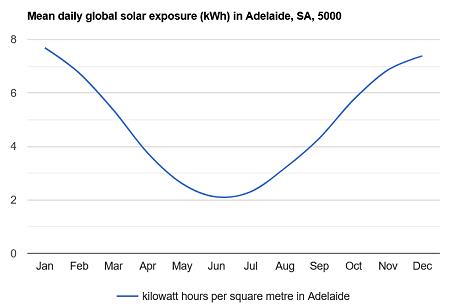The site in question is part of a 1000 m2 house block in the northern suburbs of Adelaide, South Australia. Adelaide has a Mediterranean climate (Köppen climate classification Csa), with mild wet winters and hot dry summers. Adelaide experiences solar irradiation levels reaching approximately 4.83 kilowatt-hours per square metre per day on average over a year. However, if a solar system is to be considered, the winter readings must also be considered as there may not be enough solar energy to run the system during this season.
A cursory investigation of the illumination by the Sun in December indicates that the area in the top left of the picture is shaded in the morning by the trees in the cemetery on the other side of the rear fence and shaded by the metal fence and the tool shed in the afternoon. The advantage of this site is that the tool shed has power that can be easily supplied to that area if the solar power is not enough. There is also a straight run from the rain water tanks next to the house that could be used for an automated watering system, if desired.
The rightmost area of the image and backing onto the swimming pool enclosure gets some shade in the morning from tall trees out of view in the cemetery. Being next to the swimming pool, it is a convenient location if pool water monitoring is implemented. It is also located between garden beds which would make the monitoring of ground temperature and soil moisture easy. The closest mains power is near the bottom right corner of the pool. This would mean that any power cable from that outlet would need to cross the entrance to the pool enclosure or the path around the pool.
A cursory investigation of the illumination by the Sun in December indicates that the area in the top left of the picture is shaded in the morning by the trees in the cemetery on the other side of the rear fence and shaded by the metal fence and the tool shed in the afternoon. The advantage of this site is that the tool shed has power that can be easily supplied to that area if the solar power is not enough. There is also a straight run from the rain water tanks next to the house that could be used for an automated watering system, if desired.
The rightmost area of the image and backing onto the swimming pool enclosure gets some shade in the morning from tall trees out of view in the cemetery. Being next to the swimming pool, it is a convenient location if pool water monitoring is implemented. It is also located between garden beds which would make the monitoring of ground temperature and soil moisture easy. The closest mains power is near the bottom right corner of the pool. This would mean that any power cable from that outlet would need to cross the entrance to the pool enclosure or the path around the pool.



